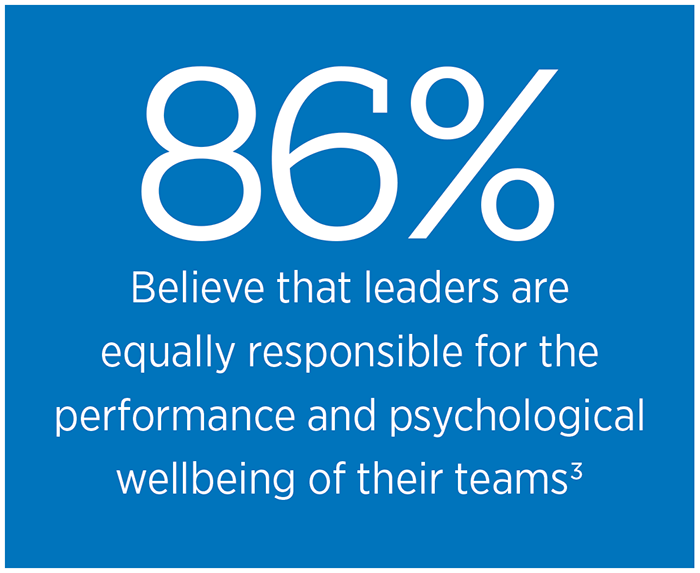Authors: Steve Bent Sally Earnshaw Siobhan Hammond

Their ability to communicate effectively with employees continues to evolve as an essential trait linked to bottom-line growth and long-term organisational health.
With a huge focus on staffing split between engaging current employees and hiring more talent, employers may have little time to work on improving leadership communications. Frankly, they might not even know whether the need exists. However, data shows that only 19% of employees strongly believe their leaders communicate effectively.1 That’s an eye-opener for the 82% of employers that agree internal communications are a key driver of the employee experience. And they would likely find this gap unacceptable.2
Promoting effective leadership through communication requires a paradigm shift from the established norm. Although connecting with the workforce has grown more complex, new possibilities for simplifying success are promising. Enhanced communication can effectively target the key outcome of attaching employees to the organisation’s purpose, mission, vision and values.
While agility is most often associated with mid-level leadership (40%), training can improve competency at any organisational level.3 Leaders who communicate effectively are more likely to not only appropriately assign and clearly define roles or tasks but also to keep agility goals and objectives in proper perspective for employees.

Creating a psychological safety net for employees
When searching for a place to work, criteria for job seekers usually include flexible schedules as well as good pay and benefits. Experiential concerns that frequently top the list are diversity and psychological safety, and a fair, equitable and secure work environment. Many employees also look for opportunities that will help them grow in their roles and advance their careers.
Communicating effectively is vital to creating a culture of safety and trust. When leaders interact openly and encourage all internal influencers to have candid discussions with employees, from line and department managers to the C-suite, they create a positive feedback loop. A greater focus on employee feedback and understanding is also linked to higher levels of talent attraction and retention.2 This emerging facet of leadership supports cohesive teamwork and better coordination between groups.
Clear communication from leaders consistently aligns what they say with what they do. Misalignment may influence employees to take cues about organisational norms from their words, not their behaviours, weakening cultural cohesion and inviting stress and burnout. In creating a psychological safety net, it helps to choose channels that are most likely to appeal to the intended audience.
More than 4 in 5 organisations (81%) increased their expectations of leaders and people managers as communicators in 2022, revealing the need for guidance through periods of challenge and change.2 And notably, 86% believe that leaders are equally responsible for their team’s performance and psychological wellbeing.3

It’s natural for organisational narratives to constantly evolve based on stories and feedback that employees share. When leaders take a strategic approach to optimising the outcomes of an ongoing employer-employee conversation, they can reduce ambiguity and anxiety while promoting confidence and productivity.
Different approaches to two-way dialogue
Some employers take a stepped approach to help ensure consistent and thorough communication. Messages move from leaders to their line or department managers, who pass them along to their employees. Using an information chain like this may benefit isolated members of remote teams the most. Because keeping an organisation- wide conversation open to everyone is essential to an interconnected and consistent employee experience, communication channels should also work in reverse.
Creating a bi-directional system to effectively communicate reinforces leadership at all levels, and often helps employees feel more comfortable about speaking up. Leaders also gain an opportunity to strengthen the psychological safety of the work environment. They’re able to demonstrate control over common barriers, which can prevent properly communicating critical feedback, such as concerns like retaliation and victimisation, or even a simple case of misinterpretation.
Optimising the connection between effective communication and leadership growth
Leaders who are highly skilled communicators tend to be adept at connecting with people across the organisation and can use this ability to develop other leaders. The most qualified prospects have a heightened sense of context. Quite often, they read situations quickly and accurately, allowing them to adapt messages to the environment while aligning them with the organisation’s goals.
Core capabilities such as problem-solving and confidence-building are usually inherent in leaders. But communication training helps to ingrain the importance of modelling the same behaviours they expect from others, including transparency. Engaging, motivating and leading people is much easier under this scenario.
The business potential of agility
Some employers may not realise the power of communication as a core tenet of building agile work teams and just how critical it has become. Helpful information, whether need-to-know or nice-to-know, can be the difference between stellar and rock-bottom team performance.
Perhaps nothing illustrates the relationship between agile strategies and processes and effective communication better than innovative responses to the challenges of the pandemic. For example, at its peak, several healthcare systems retooled marketing and communication teams to equip providers and patients with timely and accurate information about COVID-19. These employees went so far as to review the content for alignment with rapidly changing policies. Arguably, these tactics enabled more agile and prepared teams to add value to the relationship experience.
Matching communication methods with employee preferences
In-person interaction is often considered one of the best formats for transmitting verbal and nonverbal cues and conveying emotions. But remote working has diminished its importance because face-to-face encounters between leaders and employees happen less frequently.

Understanding how different communication approaches affect team agility helps to identify and hone the skills and techniques needed to improve this trait. Often, pairing communication types with individual preferences engages people more readily. However, just 3% of employers allow all employees to choose how they receive communications, 22% are starting to invest in the potential of digital, and another 28% are considering it.2
Great leaders and communicators interact with their teams in different ways. What they have in common is the ability to establish more agile environments, as they rethink how changes to work itself can engage employees more fully and motivate them to invest their best efforts.
It takes a steady focus on a clearly defined direction to communicate with distinction. And leading successfully requires a commitment to developing and enhancing the abilities required.
When practised, these life skills quickly become second nature. Leaders are able to guide employees through the ongoing process of adapting to an ever-changing work environment— more instinctively.





